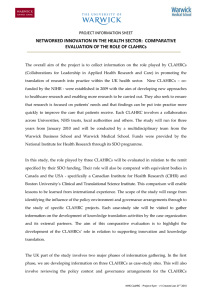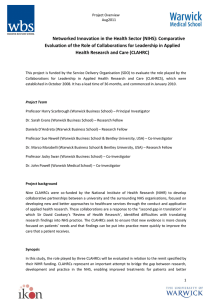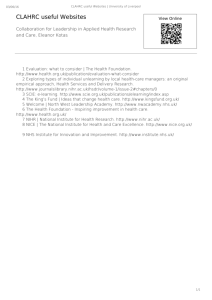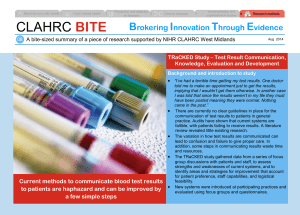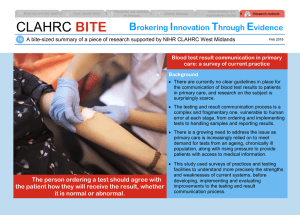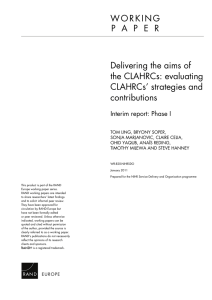Networked Innovation in the Health Sector: Comparative Evaluation of the Role of Collaborations for Leadership in Applied Health Research
advertisement
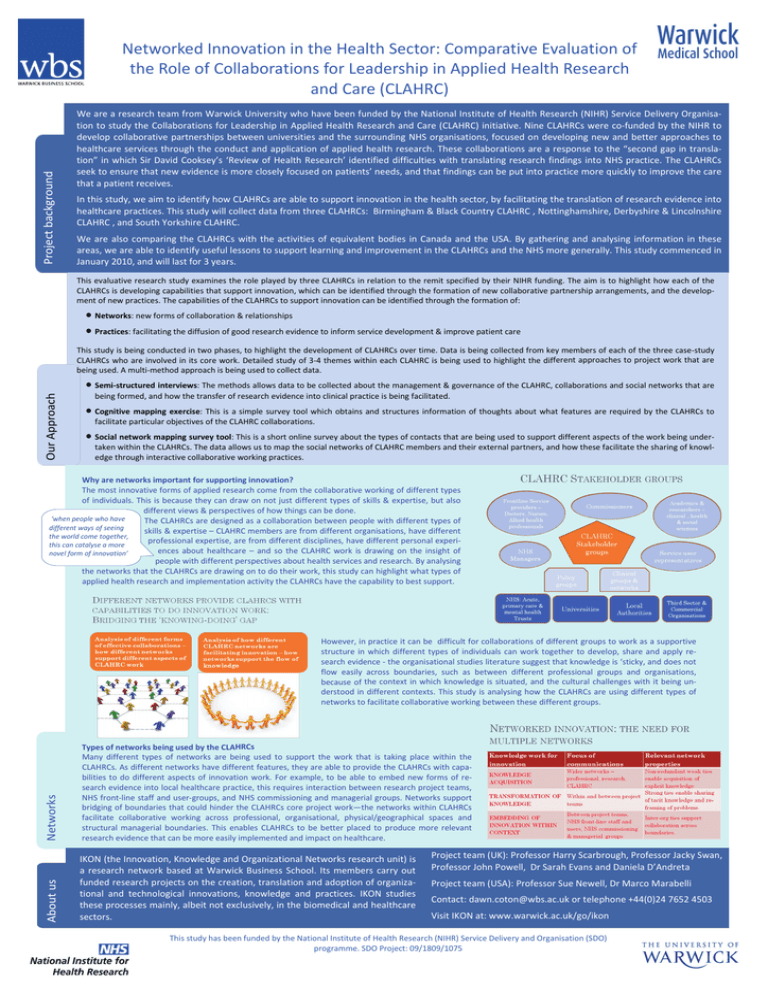
Project background Networked Innovation in the Health Sector: Comparative Evaluation of the Role of Collaborations for Leadership in Applied Health Research and Care (CLAHRC) We are a research team from Warwick University who have been funded by the National Institute of Health Research (NIHR) Service Delivery Organisa‐ tion to study the Collaborations for Leadership in Applied Health Research and Care (CLAHRC) initiative. Nine CLAHRCs were co‐funded by the NIHR to develop collaborative partnerships between universities and the surrounding NHS organisations, focused on developing new and better approaches to healthcare services through the conduct and application of applied health research. These collaborations are a response to the “second gap in transla‐ tion” in which Sir David Cooksey’s ‘Review of Health Research’ identified difficulties with translating research findings into NHS practice. The CLAHRCs seek to ensure that new evidence is more closely focused on patients’ needs, and that findings can be put into practice more quickly to improve the care that a patient receives. In this study, we aim to identify how CLAHRCs are able to support innovation in the health sector, by facilitating the translation of research evidence into healthcare practices. This study will collect data from three CLAHRCs: Birmingham & Black Country CLAHRC , Nottinghamshire, Derbyshire & Lincolnshire CLAHRC , and South Yorkshire CLAHRC. We are also comparing the CLAHRCs with the activities of equivalent bodies in Canada and the USA. By gathering and analysing information in these areas, we are able to identify useful lessons to support learning and improvement in the CLAHRCs and the NHS more generally. This study commenced in January 2010, and will last for 3 years. This evaluative research study examines the role played by three CLAHRCs in relation to the remit specified by their NIHR funding. The aim is to highlight how each of the CLAHRCs is developing capabilities that support innovation, which can be identified through the formation of new collaborative partnership arrangements, and the develop‐ ment of new practices. The capabilities of the CLAHRCs to support innovation can be identified through the formation of: • Networks: new forms of collaboration & relationships • Practices: facilitating the diffusion of good research evidence to inform service development & improve patient care Our Approach This study is being conducted in two phases, to highlight the development of CLAHRCs over time. Data is being collected from key members of each of the three case‐study CLAHRCs who are involved in its core work. Detailed study of 3‐4 themes within each CLAHRC is being used to highlight the different approaches to project work that are being used. A multi‐method approach is being used to collect data. • Semi‐structured interviews: The methods allows data to be collected about the management & governance of the CLAHRC, collaborations and social networks that are being formed, and how the transfer of research evidence into clinical practice is being facilitated. • Cognitive mapping exercise: This is a simple survey tool which obtains and structures information of thoughts about what features are required by the CLAHRCs to facilitate particular objectives of the CLAHRC collaborations. • Social network mapping survey tool: This is a short online survey about the types of contacts that are being used to support different aspects of the work being under‐ taken within the CLAHRCs. The data allows us to map the social networks of CLAHRC members and their external partners, and how these facilitate the sharing of knowl‐ edge through interactive collaborative working practices. Why are networks important for supporting innovation? The most innovative forms of applied research come from the collaborative working of different types of individuals. This is because they can draw on not just different types of skills & expertise, but also different views & perspectives of how things can be done. ‘when people who have The CLAHRCs are designed as a collaboration between people with different types of different ways of seeing skills & expertise – CLAHRC members are from different organisations, have different the world come together, professional expertise, are from different disciplines, have different personal experi‐ this can catalyse a more ences about healthcare – and so the CLAHRC work is drawing on the insight of novel form of innovation’ people with different perspectives about health services and research. By analysing the networks that the CLAHRCs are drawing on to do their work, this study can highlight what types of applied health research and implementation activity the CLAHRCs have the capability to best support. Networks Types of networks being used by the CLAHRCs Many different types of networks are being used to support the work that is taking place within the CLAHRCs. As different networks have different features, they are able to provide the CLAHRCs with capa‐ bilities to do different aspects of innovation work. For example, to be able to embed new forms of re‐ search evidence into local healthcare practice, this requires interaction between research project teams, NHS front‐line staff and user‐groups, and NHS commissioning and managerial groups. Networks support bridging of boundaries that could hinder the CLAHRCs core project work—the networks within CLAHRCs facilitate collaborative working across professional, organisational, physical/geographical spaces and structural managerial boundaries. This enables CLAHRCs to be better placed to produce more relevant research evidence that can be more easily implemented and impact on healthcare. About us However, in practice it can be difficult for collaborations of different groups to work as a supportive structure in which different types of individuals can work together to develop, share and apply re‐ search evidence ‐ the organisational studies literature suggest that knowledge is ‘sticky, and does not flow easily across boundaries, such as between different professional groups and organisations, because of the context in which knowledge is situated, and the cultural challenges with it being un‐ derstood in different contexts. This study is analysing how the CLAHRCs are using different types of networks to facilitate collaborative working between these different groups. IKON (the Innovation, Knowledge and Organizational Networks research unit) is a research network based at Warwick Business School. Its members carry out funded research projects on the creation, translation and adoption of organiza‐ tional and technological innovations, knowledge and practices. IKON studies these processes mainly, albeit not exclusively, in the biomedical and healthcare sectors. Project team (UK): Professor Harry Scarbrough, Professor Jacky Swan, Professor John Powell, Dr Sarah Evans and Daniela D’Andreta Project team (USA): Professor Sue Newell, Dr Marco Marabelli Contact: dawn.coton@wbs.ac.uk or telephone +44(0)24 7652 4503 Visit IKON at: www.warwick.ac.uk/go/ikon This study has been funded by the National Institute of Health Research (NIHR) Service Delivery and Organisation (SDO) programme. SDO Project: 09/1809/1075
